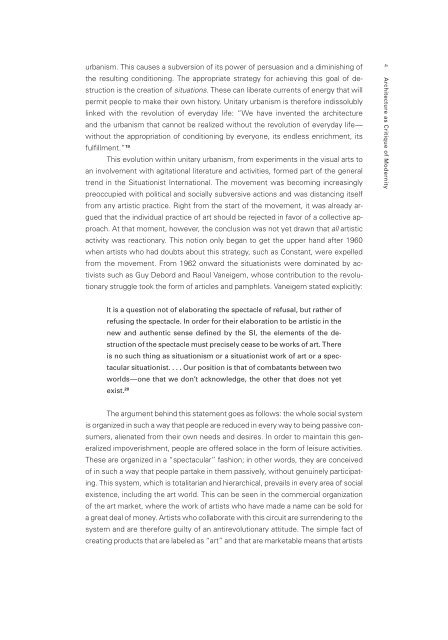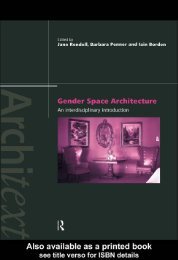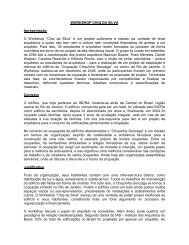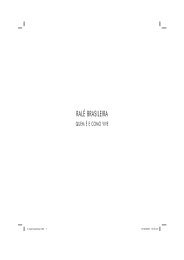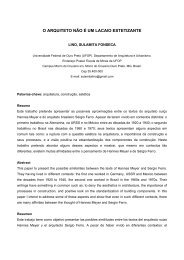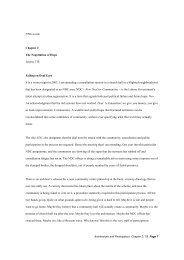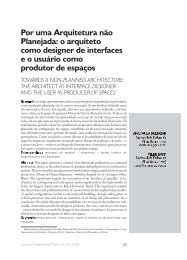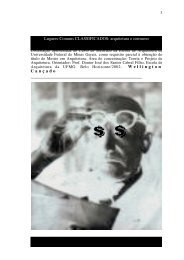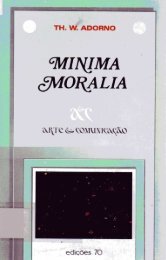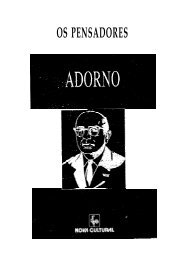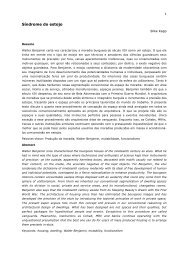Architecture and Modernity : A Critique
Architecture and Modernity : A Critique
Architecture and Modernity : A Critique
You also want an ePaper? Increase the reach of your titles
YUMPU automatically turns print PDFs into web optimized ePapers that Google loves.
urbanism. This causes a subversion of its power of persuasion <strong>and</strong> a diminishing of<br />
the resulting conditioning. The appropriate strategy for achieving this goal of destruction<br />
is the creation of situations. These can liberate currents of energy that will<br />
permit people to make their own history. Unitary urbanism is therefore indissolubly<br />
linked with the revolution of everyday life: “We have invented the architecture<br />
<strong>and</strong> the urbanism that cannot be realized without the revolution of everyday life—<br />
without the appropriation of conditioning by everyone, its endless enrichment, its<br />
fulfillment.” 19<br />
This evolution within unitary urbanism, from experiments in the visual arts to<br />
an involvement with agitational literature <strong>and</strong> activities, formed part of the general<br />
trend in the Situationist International. The movement was becoming increasingly<br />
preoccupied with political <strong>and</strong> socially subversive actions <strong>and</strong> was distancing itself<br />
from any artistic practice. Right from the start of the movement, it was already argued<br />
that the individual practice of art should be rejected in favor of a collective approach.<br />
At that moment, however, the conclusion was not yet drawn that all artistic<br />
activity was reactionary. This notion only began to get the upper h<strong>and</strong> after 1960<br />
when artists who had doubts about this strategy, such as Constant, were expelled<br />
from the movement. From 1962 onward the situationists were dominated by activists<br />
such as Guy Debord <strong>and</strong> Raoul Vaneigem, whose contribution to the revolutionary<br />
struggle took the form of articles <strong>and</strong> pamphlets. Vaneigem stated explicitly:<br />
It is a question not of elaborating the spectacle of refusal, but rather of<br />
refusing the spectacle. In order for their elaboration to be artistic in the<br />
new <strong>and</strong> authentic sense defined by the SI, the elements of the destruction<br />
of the spectacle must precisely cease to be works of art. There<br />
is no such thing as situationism or a situationist work of art or a spectacular<br />
situationist. . . . Our position is that of combatants between two<br />
worlds—one that we don’t acknowledge, the other that does not yet<br />
exist. 20<br />
The argument behind this statement goes as follows: the whole social system<br />
is organized in such a way that people are reduced in every way to being passive consumers,<br />
alienated from their own needs <strong>and</strong> desires. In order to maintain this generalized<br />
impoverishment, people are offered solace in the form of leisure activities.<br />
These are organized in a “spectacular” fashion; in other words, they are conceived<br />
of in such a way that people partake in them passively, without genuinely participating.<br />
This system, which is totalitarian <strong>and</strong> hierarchical, prevails in every area of social<br />
existence, including the art world. This can be seen in the commercial organization<br />
of the art market, where the work of artists who have made a name can be sold for<br />
a great deal of money. Artists who collaborate with this circuit are surrendering to the<br />
system <strong>and</strong> are therefore guilty of an antirevolutionary attitude. The simple fact of<br />
creating products that are labeled as “art” <strong>and</strong> that are marketable means that artists<br />
4 <strong>Architecture</strong> as <strong>Critique</strong> of <strong>Modernity</strong>


